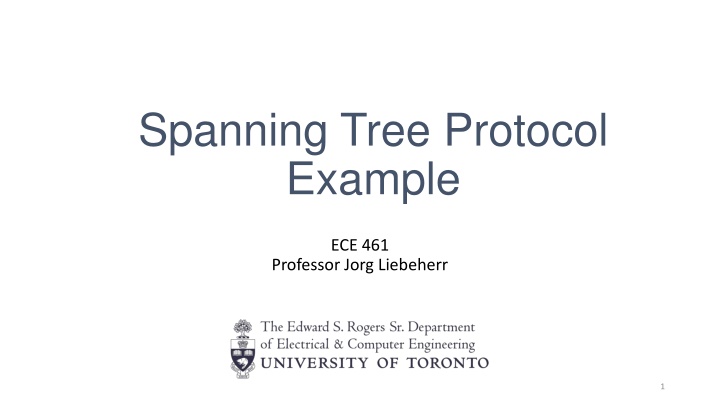
Spanning Tree Protocol Example in ECE 461 with Professor Jorg Liebeherr
Explore a detailed example of the Spanning Tree Protocol in ECE 461 by Professor Jorg Liebeherr. Understand bridge interactions, BPDU exchanges, convergence settings, and the resulting spanning tree. Follow the step-by-step process to analyze bridge configurations and network convergence.
Download Presentation

Please find below an Image/Link to download the presentation.
The content on the website is provided AS IS for your information and personal use only. It may not be sold, licensed, or shared on other websites without obtaining consent from the author. If you encounter any issues during the download, it is possible that the publisher has removed the file from their server.
You are allowed to download the files provided on this website for personal or commercial use, subject to the condition that they are used lawfully. All files are the property of their respective owners.
The content on the website is provided AS IS for your information and personal use only. It may not be sold, licensed, or shared on other websites without obtaining consent from the author.
E N D
Presentation Transcript
Spanning Tree Protocol Example ECE 461 Professor Jorg Liebeherr 1
Example Example Assume that all bridges send out their BPDU s once per second, and assume that all bridges send their BPDUs at the same time Assume that all bridges are turned on simultaneously at time T=0 sec. Bridge ID 5 Bridge ID 7 LAN LAN LAN port C port C port A port A port B port B port B Bridge ID 1 port A port A port A LAN Bridge ID 3 LAN port B port C Bridge ID 2 port B port B port C LAN port A port D LAN Bridge ID 6 2
Example: BPDUs sent by the bridges Example: BPDU s sent by the bridges Bridge 1 Bridge 2 Bridge 3 Bridge 5 Bridge 6 Bridge 7 Bridge ID 5 T=0 sec Bridge ID 7 LAN LAN LAN port C port C port A port A port B port B port B T=1 sec Bridge ID 1 port A port A port A LAN Bridge ID 3 LAN port B port C Bridge ID 2 port B port B T=2 sec port C LAN port A port D LAN Bridge ID 6 3
Example: BPDUs sent by the bridges Example: BPDU s sent by the bridges Bridge 1 Bridge 2 Bridge 3 Bridge 5 Bridge 6 Bridge 7 (1,0,1,port) (2,0,2,port) (3,0,3,port) (5,0,5,port) (6,0,6,port) (7,0,7,port) T=0 sec sent on ports: A,B ports A,B ports A,B,C ports A,B,C ports A,B,C ports A,B,C,D T=1 sec (1,0,1,port) A,B (2,0,2,port) A,B (1,1,3,port) A,C (1,1,5,port) B,C (1,1,6,port) A,C,D (1,1,7,port) A T=2 sec (1,0,1,port) A,B (1,2,2,port) none (1,1,3,port) A,C (1,1,5,port) B,C (1,1,6,port) D (1,1,7,port) none In the table (1,0,1,port) means that the BPDU is (1,0,1,A) if the BPDU is sent on port A and (1,0,1,B) if it is sent on port B At T=1, Bridge 7 receives two BPDUs from Bridge 1: (1,0,1,A) and (1,0,1,B). We assume that A is numerically smaller than B. If this is not true, then the root port of Bridge 7 changes 4
Example: Settings after convergence Example: Settings after convergence Bridge 1 Bridge 2 Bridge 3 Bridge 5 Bridge 6 Bridge 7 Root Port - A B A B B Designated Ports A,B - A,C B,C D - Blocked ports - B - - A,C A,C Bridge ID 5 Bridge ID 7 LAN LAN LAN Resulting spanning tree: port C port C port A port A port B port B port B Bridge ID 1 port A port A port A LAN Bridge ID 3 LAN port B port C Bridge ID 2 port B port B port C LAN port A port D LAN 5 Bridge ID 6



